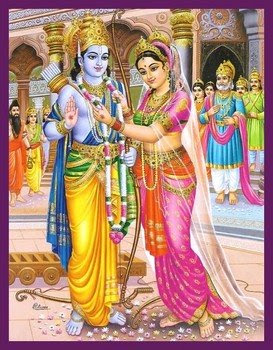PHERA and SENURA-DAAN
The moving round of the sacrificial fire is done by both bride and bridegroom. The bride holds it in her hands in front of her and the bridegroom follows her with an arm passing round her on each side, also supporting the sieve. Her brother fills the sieve as they go along with parched grain prepared in the fireplace formerly under the marhwa, which the bridegroom at the same time scatters by shaking the sieve with his hands . This ceremony is called bhawar or fera. This is performed seven times This is followed by the application of vermilion. In this the bridegroom takes a small wooden cup , sinhoura containing vermilion in one hand, and applies vermilion to the parting of the bride's hair with a piece of hemp. This is called senura daan or sindur daan...
The paddy reserved from the dhanbatti is parched in the chulha.
This
parched grain is taken with the wedding procession, and mixed with that parched
in the bride's house, and with it scattered at the phera.They then cover
the bridegroom with cosmetic ubtan, and his nails are cut , he sitting
in front of his mother, and his mother wearing the maur. This, as in the
bride's case, is called nahchhu. The
ceremony of imli ghontai is also observed .
He is then bathed and anointed, and sets out with the marriage procession. A little of the water in which he was bathed is brought with him. This is called sineh ke pani. He is not allowed to bathe again until the chauthari. When the marriage party arrives at the bride's house, this water is given to her mother, and at the time of the girl's nahchhu, the barber's wife mix it with other water, and bathe the bride with it immediately before cutting her nails.
When the bridegroom arrives at the door of the bride's house, the women of her family receive him, and scatter over him uncooked rice, the dung of a heifer, halls of cooked rice, and other articles. A married woman of the family then takes a brass pan, chhippi or thari and a diya and gives them to the bridegroom ; and then, holding two corners of her chunari, touches with them the pan, then the boy's forehead, and then her own. This is called parichhawan, parichhan or galsedi
The Marriage of Shiva & Parvati : Carved ivory with traces of tamarind juice,Madurai
He is then bathed and anointed, and sets out with the marriage procession. A little of the water in which he was bathed is brought with him. This is called sineh ke pani. He is not allowed to bathe again until the chauthari. When the marriage party arrives at the bride's house, this water is given to her mother, and at the time of the girl's nahchhu, the barber's wife mix it with other water, and bathe the bride with it immediately before cutting her nails.
When the bridegroom arrives at the door of the bride's house, the women of her family receive him, and scatter over him uncooked rice, the dung of a heifer, halls of cooked rice, and other articles. A married woman of the family then takes a brass pan, chhippi or thari and a diya and gives them to the bridegroom ; and then, holding two corners of her chunari, touches with them the pan, then the boy's forehead, and then her own. This is called parichhawan, parichhan or galsedi
The Marriage of Shiva & Parvati : Carved ivory with traces of tamarind juice,
The girl's mother then rubs in the
palm of her hand a curry pestle (lorha), which she applies to the cheeks of the
bridegroom. Ths is called gal senki.
The marking of the bridegroom's forehead with sandal paste before marriage is tilak or chandan. This is done by a man called tilkahru or tilakiya. He is generally the bride's father. This tilak is quite distinct from the tilak paid at the time of proposal of marriage.These ceremonies at the door are called collectively duar puja,also known as duar lagai. Somewhere, elder presents to the bridegroom by scattering rice achchhat over him.
When all is ready the friends of the bridegroom come with
the presents for the bride. Amongst these is a valuable cloth, culled kaneyai
or bihauti, which is taken to the female apartments, and in which she is
dressed. She is then brought out and made to sit in the marhwa. This visit is
called nirichhan, as the bridegroom's
party see the bride now for the first time.
Then the
ceremony of making the bracelet is performed.The bridegroom and seven other men
husk paddy in a mortar. When husked, two or three grains are wrapped up in
mango leaves to form a kind of bracelet. Two of these bracelets are made, and
one is tied on to the bridegroom's right wrist, and the other on the bride's
left wrist. These bracelets are called kangan. The ceremony is called athongar.Then follows the adoration of the bride. In this ceremony the elder brother of the bridegroom offers sweets,dresses and and ornaments to the bride. He then takes some betel-leaf and dahi in his right hand, and presses it against the bride's forehead, at the same time pressing his left hand against the back of her head.
These two ceremonies ars together called bandan or gurhatthi and signify that he has
touchedher once for all, and that if he touch her again he will be guilty of a
sin.
 Then the
bride's mother sits in the marhwa with the bride between her knees, holding her
round the waist. The ceremony is called nahchhu.
Then the
bride's mother sits in the marhwa with the bride between her knees, holding her
round the waist. The ceremony is called nahchhu.

0 comments:
Post a Comment